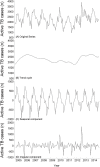Seasonality of active tuberculosis notification from 2005 to 2014 in Xinjiang, China
- PMID: 28678873
- PMCID: PMC5497978
- DOI: 10.1371/journal.pone.0180226
Seasonality of active tuberculosis notification from 2005 to 2014 in Xinjiang, China
Abstract
Objectives: Xinjiang is one of the highest TB-burdened provinces of China. A time-series analysis was conducted to evaluate the trend, seasonality of active TB in Xinjiang, and explore the underlying mechanism of TB seasonality by comparing the seasonal variations of different subgroups.
Methods: Monthly active TB cases from 2005 to 2014 in Xinjiang were analyzed by the X-12-ARIMA seasonal adjustment program. Seasonal amplitude (SA) was calculated and compared within the subgroups.
Results: A total of 277,300 confirmed active TB cases were notified from 2005 to 2014 in Xinjiang, China, with a monthly average of 2311±577. The seasonality of active TB notification was peaked in March and troughed in October, with a decreasing SA trend. The annual 77.31% SA indicated an annual mean of additional TB cases diagnosed in March as compared to October. The 0-14-year-old group had significantly higher SA than 15-44-year-old group (P<0.05). Students had the highest SA, followed by herder and migrant workers (P<0.05). The pleural TB cases had significantly higher SA than the pulmonary cases (P <0.05). Significant associations were not observed between SA and sex, ethnic group, regions, the result of sputum smear microcopy, and treatment history (P>0.05).
Conclusion: TB notification in Xinjiang shows an apparent seasonal variation with a peak in March and trough in October. For the underlying mechanism of TB seasonality, our results hypothesize that winter indoor crowding increases the risk of TB transmission, and seasonality was mainly influenced by the recent exogenous infection rather than the endogenous reactivation.
Conflict of interest statement
Figures
Similar articles
-
Seasonal variations in notification of active tuberculosis cases in China, 2005-2012.PLoS One. 2013 Jul 10;8(7):e68102. doi: 10.1371/journal.pone.0068102. Print 2013. PLoS One. 2013. PMID: 23874512 Free PMC article.
-
Seasonal variation of newly notified pulmonary tuberculosis cases from 2004 to 2013 in Wuhan, China.PLoS One. 2014 Oct 10;9(10):e108369. doi: 10.1371/journal.pone.0108369. eCollection 2014. PLoS One. 2014. PMID: 25303675 Free PMC article.
-
Seasonality of newly notified pulmonary tuberculosis in Japan, 2007-2015.BMC Infect Dis. 2019 Jun 6;19(1):497. doi: 10.1186/s12879-019-3957-8. BMC Infect Dis. 2019. PMID: 31170932 Free PMC article.
-
Seasonal variation in notified tuberculosis cases from 2014 to 2018 in eastern China.J Int Med Res. 2020 Aug;48(8):300060520949031. doi: 10.1177/0300060520949031. J Int Med Res. 2020. PMID: 32840170 Free PMC article.
-
A review of paediatric tuberculosis in Denmark: 10-year trend, 2000-2009.Eur Respir J. 2014 Mar;43(3):863-71. doi: 10.1183/09031936.00059913. Epub 2013 Aug 29. Eur Respir J. 2014. PMID: 23988765 Review.
Cited by
-
Analysis and predication of tuberculosis registration rates in Henan Province, China: an exponential smoothing model study.Infect Dis Poverty. 2020 Aug 31;9(1):123. doi: 10.1186/s40249-020-00742-y. Infect Dis Poverty. 2020. PMID: 32867846 Free PMC article.
-
Association between climate variables and pulmonary tuberculosis incidence in Brunei Darussalam.Sci Rep. 2022 May 24;12(1):8775. doi: 10.1038/s41598-022-12796-z. Sci Rep. 2022. PMID: 35610355 Free PMC article.
-
Spatial-temporal clustering of notified pulmonary tuberculosis and its predictors in East Gojjam Zone, Northwest Ethiopia.PLoS One. 2021 Jan 15;16(1):e0245378. doi: 10.1371/journal.pone.0245378. eCollection 2021. PLoS One. 2021. PMID: 33449953 Free PMC article.
-
Application of the ARIMA Model in Forecasting the Incidence of Tuberculosis in Anhui During COVID-19 Pandemic from 2021 to 2022.Infect Drug Resist. 2022 Jul 4;15:3503-3512. doi: 10.2147/IDR.S367528. eCollection 2022. Infect Drug Resist. 2022. PMID: 35813085 Free PMC article.
-
Temporal trends analysis of tuberculosis morbidity in mainland China from 1997 to 2025 using a new SARIMA-NARNNX hybrid model.BMJ Open. 2019 Jul 31;9(7):e024409. doi: 10.1136/bmjopen-2018-024409. BMJ Open. 2019. PMID: 31371283 Free PMC article.
References
-
- World Health Organization (2014) Tuberculosis Fact sheet N°104". Available: http://www.who.int/mediacentre/factsheets/fs104/en/
-
- Godfrey-Faussett P, Sonnenberg P, Shearer SC, Bruce MC, Mee C, Morris L, et al. (2000) Tuberculosis control and molecular epidemiology in a South African gold-mining community. Lancet. 2000, 356:1066–71. - PubMed
-
- Ricks PM, Cain KP, Oeltmann JE, Kammerer JS, Moonan PK. (2011) Estimating the burden of tuberculosis among foreign-born persons acquired prior to entering the U.S., 2005–2009. PLoS One 6:e27405 doi: 10.1371/journal.pone.0027405 - DOI - PMC - PubMed
-
- Fares A. (2011) Seasonality of Tuberculosis. J Glob Infect Disease 3:46–55. doi: 10.4103/0974-777X.77296 - DOI - PMC - PubMed
MeSH terms
LinkOut - more resources
Full Text Sources
Other Literature Sources


